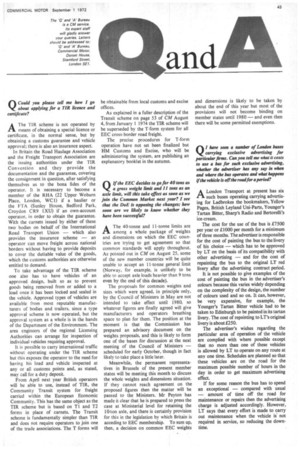Q Could you please tell me how I go about applying for a TIR licence and certificate?
Page 49

If you've noticed an error in this article please click here to report it so we can fix it.
AThe TIR scheme is not operated by means of obtaining a special licence or certificate, in the normal sense, but by obtaining a customs guarantee and vehicle approval; there is also an insurance aspect.
In Britain the Road Haulage Association and the Freight Transport Association are the issuing authorities under the TIR Convention and they provide the documentation and the guarantee, covering the consignment in question, after satisfying themselves as to the bona fides of the operator. It is necessary to become a member of the RHA (22 Upper Woburn Place. London, WC1) if a haulier or the FTA (Sunley House, Bedford Park, Croydon CR9 1XU) if an own-account operator, in order to obtain the guarantee. With the carnets issued by either of these two bodies on behalf of the International Road Transport Union — which also provides the insurance scheme — an operator can move freight across national borders without having to provide deposits to cover the dutiable value of the goods, which the customs authorities are otherwise entitled to demand.
To take advantage of the TIR scheme one also has to have vehicles of an approved design, built so as to prevent goods being removed from or added to a load once it has been locked and sealed in the vehicle. Approved types of vehicles are available from most reputable manufacturers of bodies and trailers, since a type approval scheme is now operated, but the approval system as a whole is in the hands of the Department of the Environment. The area engineers of the regional Licensing Authorities can arrange for inspection of individual vehicles requiring approval.
It is possible to carry international traffic without operating under the TIR scheme but this exposes the operator to the need for having his load and vehicle inspected at any or all customs points and, as stated, may call for a duty deposit.
From April next year British operators will be able to use, instead of TIR, the Community Transit system for freight carried within the European Economic Community. This has the same object as the TIR scheme but is based on Ti and T2 forms in place of carnets. The Transit scheme is fundamentally simpler than TIR and does not require operators to join one of the trade associations. The T forms will be obtainable from local customs and excise offices.
As explained in a fuller description of the Transit scheme on page 53 of CM August 4, from January I 1974 the TIR scheme will be superseded by the T-form system for all EEC cross-border road freight.
The precise procedures for T-form operation have not set been finalized but HM Customs and Excise, who will be administering the system, are publishing an explanatory booklet in the autumn.


































































































